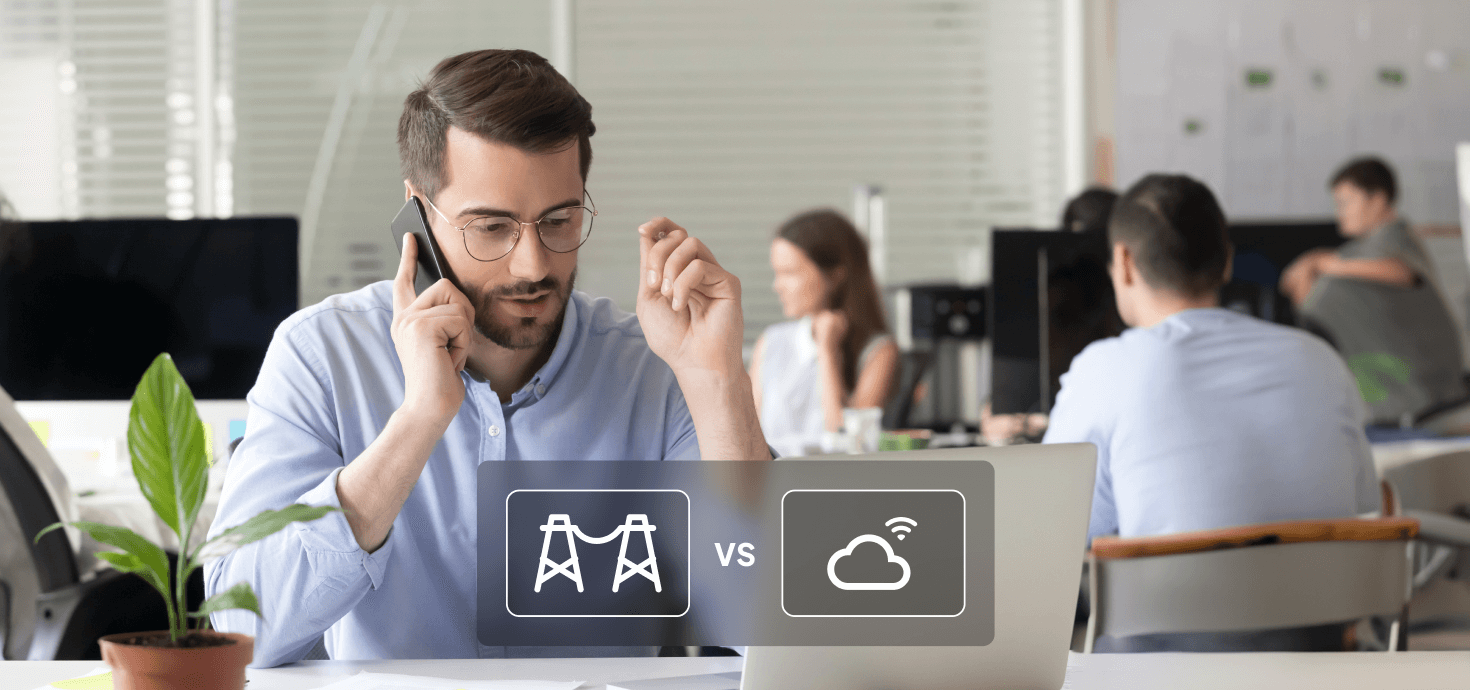
At their core, both PRI and SIP trunking are designed to enhance business telephony by enhancing the capacity and connectivity of existing systems. While PRI is a traditional system transmitting voice and data over dedicated physical lines, SIP trunking is more modern and Internet-based.
Knowing the difference between PRI vs SIP technologies is not just about keeping up with the latest telecom trends—it’s about making strategic decisions that influence your company’s bottom line.
In this article, we dive into the definitions of PRI and SIP trunking, as well as their key differences and use cases. Keep reading to find out what they are.
What is PRI?
The Primary Rate Interface (PRI) is a telecommunications standard used in the Integrated Services Digital Network (ISDN) for carrying multiple Digital Signal 0 (DS0) voice and data transmissions between a network and a user.
Businesses typically use PRI the Public Switched Telephone Network (PSTN), offering a high-capacity service through a single physical line or circuit. This interface allows for simultaneous voice, data, and video traffic transmission.
Historically, the PRI was introduced in the 1980s as part of the ISDN to provide a digital communication method that would be more reliable and flexible than traditional analog systems. It was the first to support modern services such as video conferencing and direct inward dialing, leading to a more efficient use of physical phone lines.
PRI quickly became popular in business, allowing companies to connect their PBX systems to the PSTN with greater control over their communications infrastructure.
Over time, as the Voice over Internet Protocol (VoIP) and other IP-based technologies emerged, the use of PRI has declined. However, it still remains in use as it caters to specific business needs. Some of its key features include:
- Digital transmission of voice and data
- Support for multiple DS0 channels on a single line
- Compatibility with traditional PBX systems
- Consistent and reliable connection quality
- Caller ID, call waiting, and call forwarding

What is SIP Trunking?
Session Initiation Protocol (SIP) trunking is a technology that enables sending voice communications over the Internet. This is achieved by connecting an IP-enabled Private Branch Exchange (PBX) to the global telephone network, leveraging the power of VoIP.
SIP trunking is the modern alternative to PRIs, converting voice calls into digital packets that travel over the internet from an IP-PBX to an SIP provider. It has several key features:
- Direct Internet routing for calls
- Voicemail and call queues
- Real-time session management
- Encryption and secure communications
- Multimedia support, including video and SMS
Due to these capabilities, SIP trunking seamlessly integrates with Communications Platforms as a Service (CPaaS), offering businesses a comprehensive suite of communication tools. For more detailed information on how it works and its benefits, check out our dedicated blog article about SIP trunking.
PRI vs. SIP Trunking: Which is best for you?
PRI and SIP trunking are two distinct technologies at their core, as one relies on physical lines and the other on the Internet. But what does that mean for your business? This section explores their differences in terms of technical aspects, cost implications, scalability, and reliability.
Technical comparison
- Bandwidth allocation: PRI operates over physical lines without using Internet bandwidth and is thus unaffected by fluctuations or outages. SIP trunking utilizes Internet bandwidth, meaning call capacity and quality can vary depending on system status.
- Call quality and security: PRI has physical lines that provide consistent call quality and security, although are still susceptible to fluctuations. SIP trunking offers advanced encryption and security measures, but call quality may vary depending on the Internet connection.
- Infrastructure requirements: PRI requires a PBX system and PRI interface for connectivity; fixed hardware is more time-consuming to upgrade. SIP trunking leverages existing internet connections and IP-PBX systems, which is easier to integrate with new technologies.
Cost implications
- Initial setup and ongoing costs: PRI has higher initial and ongoing costs due to the demands of physical phone lines and connected infrastructure. Depending on your provider, SIP trunking has lower initial and ongoing costs, with minimal physical infrastructure needed.
- Potential savings and ROI: PRI offers limited savings potential; ROI is primarily realized through reliable service and quality. SIP trunking has a high potential for savings on monthly bills and international calls, with a quicker ROI due to lower overall costs.
Scalability and flexibility
- Ease of adding lines and channels: With PRI, adding lines requires new circuits and potentially new hardware, making scalability slower and more expensive. With SIP trunking, lines or channels can be added quickly and often without additional hardware.
- Geographic flexibility and limitations: PRI physical phone lines are tied to specific geographic locations, making flexibility limited and heavily dependent on additional infrastructure. SIP trunking offers significant geographic flexibility, allowing for remote work and operation in multiple regions without physical infrastructure.
Reliability and redundancy
- Uptime and quality of service: PRI has high levels of reliability and QoS due to dedicated lines but is susceptible to physical damage that can be slow to repair. SIP trunking relies on internet quality and provider reliability, with advanced features that can prioritize voice traffic to improve call quality.
- Disaster recovery options: PRI is limited by physical infrastructure; recovery can be challenging if physical damage occurs. SIP trunking comes with more flexible disaster recovery options, allowing for quick rerouting of calls to unaffected locations or devices.
PRI vs SIP: Advantages and disadvantages
PRI vs SIP trunking have their unique advantages and disadvantages. In the two following sections, we’ve explored them in greater detail.
PRI advantages and disadvantages
First, let’s have a look at the benefits and limitations of PRI. In the table below, you will find some insights into this:
| Advantages of PRI | Disadvantages of PRI |
|---|---|
| High-quality, reliable voice and data transmission | Requires dedicated physical lines, increasing infrastructure costs |
| Supports multiple simultaneous calls on a single line | Less scalable, expanding requires additional physical lines |
| Offers advanced telephony features (caller ID, call waiting, etc) | Limited flexibility in adjusting to changing business needs |
| Consistent performance unaffected by Internet bandwidth | Being phased out by more modern, Internet-based technologies |
| Direct integration with existing telecommunication infrastructure | Requires specialized on-premise maintenance and support |
| Precise billing and usage tracking | Initial setup and equipment can be expensive |
SIP trunking advantages and disadvantages
Next, let’s explore the pros and cons of SIP trunking. The table below details them to help you make an informed decision tailored to your business needs.
| Advantages of SIP trunking | Disadvantages of SIP trunking |
|---|---|
| Reduces implementation costs by eliminating physical lines | Relies on internet bandwidth, affecting call quality during network congestion |
| Easily adjusts to growing or changing business needs | Setup and configuration can be complex and require a specialized team |
| Facilitates global reach with local presence capabilities | May require additional training for IT staff and users |
| Supports advanced call management and unified communications | Might not be supported by all older telecommunication systems |
| Offers detailed call analytics and reporting for better insights | Opens new security risks if not properly encrypted and secured |
| Provides disaster recovery options for business continuity | Limited emergency calling capabilities in some regions |
Use cases and decision factors
Both PRI and SIP trunking offer unique advantages that cater to different organizational needs. Understanding their different use cases, as well as what to consider when making a final decision is thus essential in enhancing your company’s communication infrastructure.
Ideal use cases for PRI
Organizations that have already implemented PBX can easily integrate PRI into their existing infrastructure. The technology fits perfectly into this setup, providing a stable and reliable connection without requiring a complete overhaul of existing telephony systems.
PRI is also a solid choice for industries where security and reliability are crucial, such as financial institutions, healthcare, and government agencies. By way of dedicated physical lines, the system is able to ensure consistent call quality and data protection.
Ideal use cases for SIP Trunking
SIP trunking shines in environments that thrive on flexibility and scalability. Startups and expanding businesses can thus benefit from its ability to add or change lines and services without significant infrastructure changes.
Companies looking to reduce operational costs while enhancing communication capabilities will also find SIP trunking to be an attractive option. Businesses can significantly lower their monthly telephony expenses by leveraging internet connectivity for voice and video.
Factors to consider when choosing
There are some important factors to consider when choosing between PRI and SIP trunking. We’ve listed the most relevant ones below:
- Compatibility with existing business infrastructure
- Flexibility and scalability supporting future growth
- Initial setup and ongoing expenses for each system
- Reliance on Internet connectivity vs physical lines
- Support for remote work through geographic adaptability
- Disaster recovery features for business continuity
Evaluating these factors in the context of your business requirements and priorities is the best way to choose a solution that aligns with your organizational objectives and communication requirements—regardless of whether that will be PRI or SIP trunking.
If your company could benefit from both systems, keep in mind that SIP trunking can be integrated with existing PRI trunks. This is ideal if you want to upgrade your existing physical infrastructure and have both PRI and SIP trunks to serve different needs within the organization.
Conclusion
PRI and SIP trunking serve distinct business needs, and the difference boils down to using physical phone lines versus the Internet. Ultimately, choosing between them should align with a business’s size and long-term goals.
SMBs aiming for growth might lean towards SIP trunking for its scalability, cost efficiency, and advanced features. Large enterprises or organizations with stringent security and reliability requirements might prefer PRI for its robust and stable communications infrastructure.
PRI also enables faxing, which can be important to organizations that depend on this type of communication (i.e. hospitals, government institutions, banks, or law firms).
Whatever the case might be for you, making the right choice for your company is quintessential to an efficient telecommunication strategy that paves the way for future success.
Related articles
How to use an employee text messaging system for internal staff communication
As traditional companies gradually get replaced by b...
62 Customer service email templates for every situation
Clients expect fast and reliable service that meets ...
6 Proven sales funnel templates to accelerate your growth
Discover the top sales funnel templates that will h...
71 Customer satisfaction survey questions by user journey
Gathering customer feedback is crucial for improving...
Voice of the customer survey questions and best practices
As a business owner or marketer, you want to ensure ...




